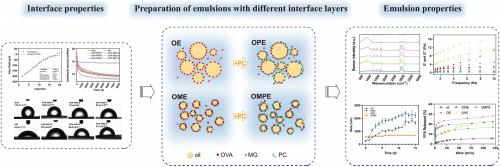天然非营养性甜味剂甜苷与卵清蛋白相互作用,改善卵清蛋白/柑橘果胶双层乳状液的性能
IF 11
1区 农林科学
Q1 CHEMISTRY, APPLIED
引用次数: 0
摘要
天然零热量甜味剂甜苷(MG)由于其独特的结构,具有一定的表面活性。本研究将MG与卵清蛋白(OVA)混合,并采用等温滴定量热法(ITC)研究了MG与OVA之间的相互作用。发现MG与OVA的自发结合主要由疏水相互作用和氢键驱动。这种结合使OVA的界面张力从9.51 mN/m降低到7.78 mN/m,接触角从115.1±1.6°降低到88.9±0.5°。此外,通过静电沉积将柑桔果胶(PC)吸附在OVA-MG配合物表面,制备了双层乳液。利用Zeta电位和共聚焦激光扫描显微镜证实了双层乳液的形成。对不同的界面组成对乳液性能的影响进行了全面的研究。结果表明,MG和PC的存在在一定程度上提高了乳液对外部环境应力的抵抗能力。共聚焦拉曼光谱显示,MG促进了蛋白与脂链之间的相互作用,这也可能影响乳液的流变行为。此外,还对不同界面层加载β-胡萝卜素乳剂的体外消化特性进行了评价。结果表明,MG显著提高了游离脂肪酸的释放量和β-胡萝卜素的递送效率。本实验为MG在食品工业中的应用提供了新的视角。本文章由计算机程序翻译,如有差异,请以英文原文为准。

Natural non-nutritive sweetener mogroside interacts with ovalbumin to improve the properties of ovalbumin/citrus pectin bilayer emulsion
Due to its unique structure, the natural zero-calorie sweetener mogroside (MG) has certain surface activity. This study mixed MG with ovalbumin (OVA) and investigated the interaction between MG and OVA using isothermal titration calorimetry (ITC). It was found that the spontaneous binding between MG and OVA was driven mainly by both hydrophobic interactions and hydrogen bonds. This binding reduced the interfacial tension of OVA from 9.51 mN/m to 7.78 mN/m and the contact angle from 115.1 ± 1.6° to 88.9 ± 0.5°. In addition, a bilayer emulsion was prepared by adsorbing citrus pectin (PC) onto the surface of the OVA-MG complex via electrostatic deposition. Zeta potential and confocal laser scanning microscopy were used to confirm the formation of the bilayer emulsion. A comprehensive investigation of how varying interfacial compositions impacted emulsion properties was conducted. It was found that the presence of MG and PC could improve the resistance of the emulsion to external environmental stress to a certain extent. Confocal Raman spectroscopy showed that MG promoted the interaction between proteins and lipid chains, which might also affect the rheological behavior of the emulsion. In addition, the in vitro digestion characteristics of emulsions with different interface layers loading β-carotene were evaluated. The results showed that MG significantly increased the release of free fatty acids and the delivery efficiency of β-carotene. This experiment offers fresh perspectives on the application of MG in the food industry.
求助全文
通过发布文献求助,成功后即可免费获取论文全文。
去求助
来源期刊

Food Hydrocolloids
工程技术-食品科技
CiteScore
19.90
自引率
14.00%
发文量
871
审稿时长
37 days
期刊介绍:
Food Hydrocolloids publishes original and innovative research focused on the characterization, functional properties, and applications of hydrocolloid materials used in food products. These hydrocolloids, defined as polysaccharides and proteins of commercial importance, are added to control aspects such as texture, stability, rheology, and sensory properties. The research's primary emphasis should be on the hydrocolloids themselves, with thorough descriptions of their source, nature, and physicochemical characteristics. Manuscripts are expected to clearly outline specific aims and objectives, include a fundamental discussion of research findings at the molecular level, and address the significance of the results. Studies on hydrocolloids in complex formulations should concentrate on their overall properties and mechanisms of action, while simple formulation development studies may not be considered for publication.
The main areas of interest are:
-Chemical and physicochemical characterisation
Thermal properties including glass transitions and conformational changes-
Rheological properties including viscosity, viscoelastic properties and gelation behaviour-
The influence on organoleptic properties-
Interfacial properties including stabilisation of dispersions, emulsions and foams-
Film forming properties with application to edible films and active packaging-
Encapsulation and controlled release of active compounds-
The influence on health including their role as dietary fibre-
Manipulation of hydrocolloid structure and functionality through chemical, biochemical and physical processes-
New hydrocolloids and hydrocolloid sources of commercial potential.
The Journal also publishes Review articles that provide an overview of the latest developments in topics of specific interest to researchers in this field of activity.
 求助内容:
求助内容: 应助结果提醒方式:
应助结果提醒方式:


